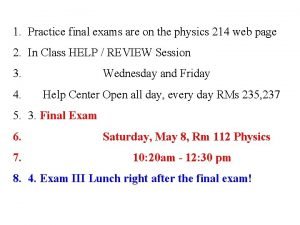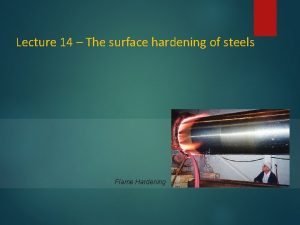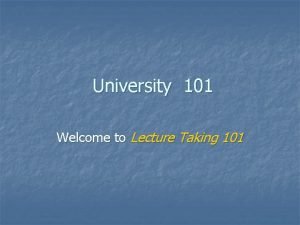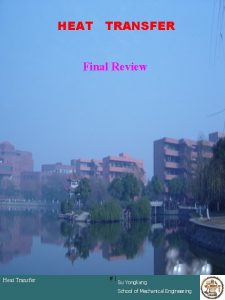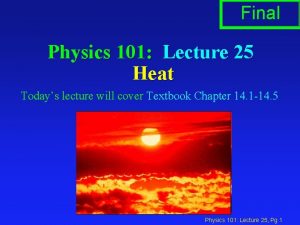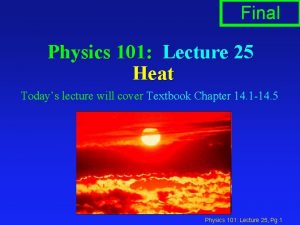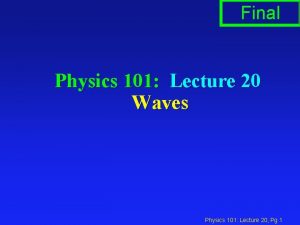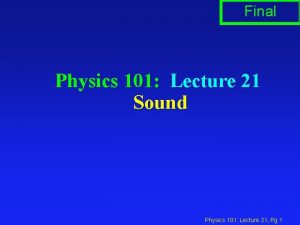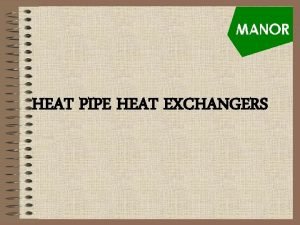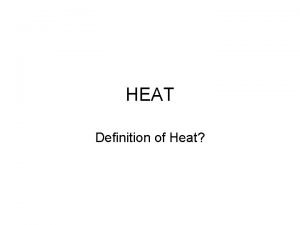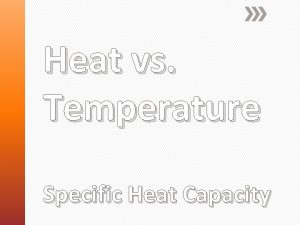Final Physics 101 Lecture 23 Heat Physics 101














- Slides: 14

Final Physics 101: Lecture 23 Heat Physics 101: Lecture 23, Pg 1

Heat l Definition: Flow of energy between two objects due to difference in temperature èNote: similar to WORK èObject does not “have” heat (it has energy: temp) l Units: Joule è 4186 Joules = 1 Calorie = 1000 calories = ècalorie: Amount of heat needed to raise 1 g of water 1ºC Physics 101: Lecture 23, Pg 2 10

Example: Sears Tower l You decide to take the stairs to the top of the Sears tower (442 m). If you have a weight of 670 N and your body was 100% efficient in converting food into mechanical energy. How many Calories would you need to eat to replenish your body Whopper with Cheese: 696 Cal Big Mac with Cheese: 560 Cal Physics 101: Lecture 23, Pg 3

Specific Heat l Heat adds energy to object/system l IF system does NO work then: èHeat increases internal energy. Q = U èHeat increases temperature! l. Q = c m T èHeat required to increase Temp depends on amount of material (m) and type of material (c) l Q = cm T : “Cause” = “inertia” x “effect” (just like F=ma) è cause = Q è effect = T è inertia = cm (mass x specific heat capacity) l T = Q/cm (just like a = F/m) Physics 101: Lecture 23, Pg 4 15

Question l After a grueling work out, you drink a liter of cold water (0 C). How many Calories does it take for your body to raise the water up to body temperature of 36 C? 1) 36 2) 360 3) 3, 600 4) 36, 000 1 liter = 1, 000 grams of H 20 1000 g x 1 calorie/(gram degree) x (36 degree) = 36, 000 calories = 36 Calories! Physics 101: Lecture 23, Pg 5 18

Question Suppose you have two insulated buckets containing the same amount of water at room temperature. You also happen to have two blocks of metal of the same mass, both at the same temperature, warmer than the water in the buckets. One block is made of aluminum and one is made of copper. You put the aluminum block into one bucket of water, and the copper block into the other. After waiting a while you measure the temperature of the water in both buckets. Which is warmer? 1. The water in the bucket containing the aluminum block 2. The water in the bucket containing the copper block 3. The water in both buckets will be at the same temperature Substance aluminum copper c in J/(kg-C) 900 387 Since aluminum has a higher specific heat than copper, you are adding more heat to the water when you dump the aluminum in the bucket (q=mc T). Physics 101: Lecture 23, Pg 6 20

Specific Heat Question Suppose you have equal masses of aluminum and copper at the same initial temperature. You add 1000 J of heat to each of them. Which one ends up at the higher final temperature A) aluminum B) copper C) the same Substance aluminum copper iron lead human body water ice c in J/(kg-C) 900 387 452 128 3500 4186 2000 T = Q/cm Physics 101: Lecture 23, Pg 7 23

Latent Heat L l As you add heat to water, the temperature increases for a while, then it remains constant, despite the additional heat! T Substance water l Latent Lf (J/kg) 33. 5 x 104 100 o. C Lv (J/kg) 22. 6 x 105 water temp rises water changes to steam (boils) steam temp rises Latent Heat Q added to water Heat L [J/kg] is heat which must be added (or removed) for material to change phase (liquidgas). Physics 101: Lecture 23, Pg 8 28

Ice Question l Which will do a better job cooling your soda, a “cooler” filled with water at 0 C, or a cooler filled with ice at 0 C. A) Water B) About Same C) Ice Latent Heat L [J/kg] is heat which must be added (or removed) for material to change phase (liquidwater ice gas). ice T Substance water Lf (J/kg) 33. 5 x 104 0 o. C Lv (J/kg) 22. 6 x 105 temp rises changes to water (melts) temp rises Latent Heat Q added to water Physics 101: Lecture 23, Pg 9 30

Example: sweat l During a tough work out, your body sweats (and evaporates) 1 liter of water to keep cool (37 C). How much water would you need to drink (at 2 C) to achieve the same thermal cooling? (recall CV = 4. 2 J/g for water, Lv=2. 2 x 103 J/g) Physics 101: Lecture 23, Pg 10 33

Question Summers in Phoenix Arizona are very hot (125 F is not uncommon), and very dry. If you hop into an outdoor swimming pool on a summer day in Phoenix, you will probably find that the water is too warm to be very refreshing. However, when you get out of the pool and let the sun dry you off, you find that you are quite cold for a few minutes (yes. . . you will have goose-bumps on a day when the air temperature is over 120 degrees). How can you explain this? Physics 101: Lecture 23, Pg 11 35

Example: ice and water How much ice (at 0 C) do you need to add to 0. 5 liters of a water at 25 C, to cool it down to 10 C? (L = 80 cal/g, c = 1 cal/g C , cice = 0. 5 cal/g C) l Physics 101: Lecture 23, Pg 12

Example: ice and water 2 l 0. 8 kg of ice (at -10 o C) is added to 1. 4 kg of water at 20 o C, How much of the ice will melt? (Lf = 33. 5 x 104 J/kg, cwater = 4186 J/kg C, cice = 2000 J/kg C) Physics 101: Lecture 23, Pg 13

Summary l Heat is FLOW of energy èFlow of energy may increase temperature l Specific Heat è t = Q / (c m) èMonatomic IDEAL Gas CV = 3/2 R èDiatomic IDEAL Gas CV = 5/2 R l Latent Heat èheat associated with change in phase Physics 101: Lecture 23, Pg 14
 What is a harmonic wave in physics
What is a harmonic wave in physics Physics 101 lecture 1
Physics 101 lecture 1 Physics 101 lecture notes pdf
Physics 101 lecture notes pdf Waves notes pdf download
Waves notes pdf download Physics 101 final exam
Physics 101 final exam 01:640:244 lecture notes - lecture 15: plat, idah, farad
01:640:244 lecture notes - lecture 15: plat, idah, farad Heat treatment of steel lecture notes
Heat treatment of steel lecture notes Lecture 101
Lecture 101 Heat transfer final exam
Heat transfer final exam Wipo dl 101
Wipo dl 101 Classical mechanics
Classical mechanics Atmospheric physics lecture notes
Atmospheric physics lecture notes Specific heat capacity
Specific heat capacity Formula for specific latent heat
Formula for specific latent heat Example of combination cooking method
Example of combination cooking method




